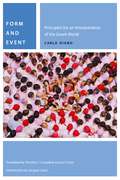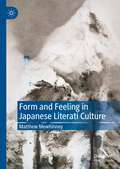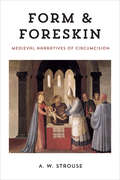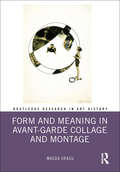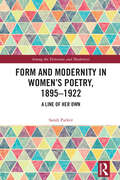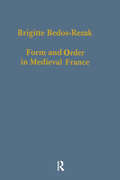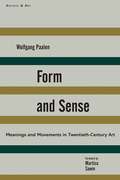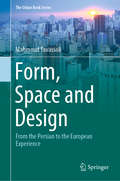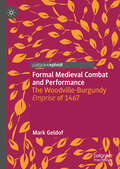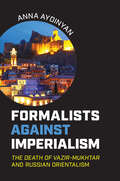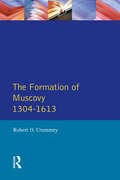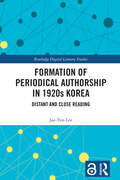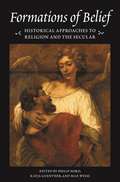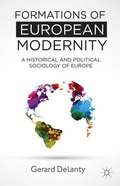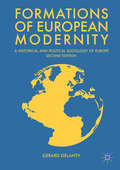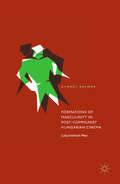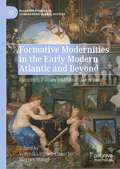- Table View
- List View
Form and Event: Principles for an Interpretation of the Greek World (Commonalities)
by Carlo DianoCarlo Diano’s Form and Event has long been known in Europe as a major work not only for classical studies but even more for contemporary philosophy. Already available in Italian, French, Spanish, and Greek, it appears here in English for the first time, with a substantial Introduction by Jacques Lezra that situates the book in the genealogy of modern political philosophy.Form and Event reads the two classical categories of its title phenomenologically across Aristotle, the Stoics, and especially Homer. By aligning Achilles with form and Odysseus with event, Diano links event to embodied and situated subjective experience that simultaneously finds its expression in a form that objectifies that experience. Form and event do not exist other than as abstractions for Diano but they do come together in an intermingling that Diano refers to as the “eventic form.” On Diano’s reading, eventic forms interweave subjectively situated and embodied experiences, observable in all domains of human and nonhuman life.A stunning interpretation of Greek antiquity that continues to resonate since its publication in 1952, Form and Event anticipates the work of such French and Italian post-war thinkers as Gilles Deleuze, Alain Badiou, Roberto Esposito, and Giorgio Agamben.
Form and Feeling in Japanese Literati Culture
by Matthew MewhinneyThis book explores how two early modern and two modern Japanese writers – Yosa Buson (1716–83), Ema Saikō (1787–1861), Masaoka Shiki (1867–1902), and Natsume Sōseki (1867–1916) – experimented with the poetic artifice afforded by the East Asian literati (bunjin) tradition, a repertoire of Chinese and Japanese poetry and painting. Their experiments generated a poetics of irony that transformed the lineaments of lyric expression in literati culture and advanced the emergence of modern prose poetry in Japanese literature. Through rigorous close readings, this study changes our understanding of the relationship between lyric form and the representation of self, sense, and feeling in Japanese poetic writing from the late eighteenth through the early twentieth century. The book aims to reach a broad audience, including specialists in East Asian Studies, Anglophone literary studies, and Comparative Literature.
Form and Foreskin: Medieval Narratives of Circumcision
by A. W. StrouseWhy did Saint Augustine ask God to “circumcise [his] lips”? Why does Sir Gawain cut off the Green Knight’s head on the Feast of the Circumcision? Is Chaucer’s Wife of Bath actually—as an early glossator figures her—a foreskin? And why did Ezra Pound claim that he had incubated The Waste Land inside of his uncut member? In this little book, A. W. Strouse excavates a poetics of the foreskin, uncovering how Patristic theologies of circumcision came to structure medieval European literary aesthetics. Following the writings of Saint Paul, “circumcision” and “uncircumcision” become key terms for theorizing language—especially the dichotomies between the mere text and its extended exegesis, between brevity and longwindedness, between wisdom and folly. Form and Foreskin looks to three works: a peculiar story by Saint Augustine about a boy with the long foreskin; Sir Gawain and the Green Knight; and Chaucer’s Wife of Bath’s Tale. By examining literary scenes of cutting and stretching, Strouse exposes how Patristic treatments of circumcision queerly govern medieval poetics.
Form and Meaning in Avant-Garde Collage and Montage (Routledge Research in Art History)
by Magda DraguThis book uses intermedial theories to study collage and montage, tracing the transformation of visual collage into photomontage in the early avant-garde period. Magda Dragu distinguishes between the concepts of collage and montage, as defined across several media (fine arts, literature, music, film, photography), based on the type of artistic meaning they generate, rather than the mechanical procedures involved. The book applies theories of intermediality to collage and montage, which is crucial for understanding collage as a form of cultural production. Throughout, the author considers the political implications, as collages and montages were often used for propagandistic purposes. This book combines research methods used in several areas of inquiry: art history, literary criticism, analytical philosophy, musicology, and aesthetics.
Form and Modernity in Women’s Poetry, 1895–1922: A Line of Her Own (Among the Victorians and Modernists)
by Sarah ParkerWhile W. B. Yeats’s influential account of the ‘Tragic Generation’ claims that most fin-de-siècle poets died, or at least stopped writing, shortly after 1900, this book explodes this narrative by attending to the twentieth-century poetry produced by women poets Alice Meynell, Michael Field (Katharine Bradley and Edith Cooper), Dollie Radford, and Katharine Tynan. While primarily associated with the late nineteenth century, these poets were active in the twentieth century, but their later writing is overlooked in modernist-dominated studies, partly due to this poetry’s adherence to traditional form. This book reveals that these poets, far from being irrelevant to modernity, used these established forms to address contemporary concerns, including suffrage, sexuality, motherhood, and the First World War. The chapters focus on Meynell’s manipulations of metre to contemplate temporality and literary tradition; Michael Field’s use of blank verse to portray the conflicted modern woman; Radford’s adaptation of the aesthetic song-like lyric to tackle the experience of the city, urban crime, and suffrage; and Tynan’s employment of the ballad to soothe bereaved mothers during the First World War. This book ultimately shows that traditional forms played a vital role in shaping mature women poets’ responses to modernity, illuminating debates about form, tradition, and gender in twentieth-century poetry.
Form and Order in Medieval France: Studies in Social and Quantitative Sigillography (Variorum Collected Studies)
by Brigitte Bedos-RezakBy the early 13th century the use of seals in Northern Europe was a generalized phenomenon which involved society as a whole, crossing boundaries of gender, age, religion, and social and professional status. The function traditionally ascribed to seals is the validation of the documents to which they were affixed, but the phenomenon has far wider implications, as is brought out in this collection of studies by Brigitte Bedos-Rezak. In itself a seal could serve as a quasi-amuletic object or a personal adornment, the image impressed from it functioned as a sign conveying identity and power, and the ritual of sealing provided an occasion for the affirmation of status. In her work the author has aimed to use the approaches of statistics, cultural and women’s history and semiotics, as well as the ’traditional’ skills of art history, law and diplomatics, to show the numerous surviving seals can be used to reach into the history of the Middle Ages, and at the same time to explore and test the interpretative models suggested by semiotics and postmodern theories on symbols, representation and meaning.
Form and Sense
by Deborah Rosenthal Wolfgang Paalen Martica SawinWolfgang Paalen was a central figure in internationalist surrealist circles in the late 1930s. Artist and intellectual, he was a European whose fascination with archaic cultures led him finally to Mexico, where he founded the influential magazine DYN in 1941. In the bold texts from DYN that make up Form and Sense, we encounter a unique artistic mind and an oracular voice.Paalen's book is an intellectual delight with essays on cubism, surrealism, the universality of forms in architecture, and the relationships that exist between art and science. He weaves together the new ideas and archaic inspirations in twentieth-century painting and sculpture. His nuanced and original considerations of some key figures--Mondrian, Kandinsky, Picasso--marked Paalen in turn as a significant thinker in the world of modern art.This painter's book, illustrated with carefully chosen examples of the art he examines, makes us not only understand but also experience the rich interplay between idea and image that informs the art of our own time. A new introduction by the scholar Martica Sawin examines Paalen's career, particularly his influential writing on surrealism and abstraction.
Form as Revolt: Carl Einstein and the Ground of Modern Art
by Sebastian ZeidlerThe German writer and art critic Carl Einstein (1885-1940) has long been acknowledged as an important figure in the history of modern art, and yet he is often sidelined as an enigma. In Form as Revolt Sebastian Zeidler recovers Einstein's multifaceted career, offering the first comprehensive intellectual biography of Einstein in English. Einstein first emerged as a writer of experimental prose through his involvement with the anarchist journal Die Aktion. After a few limited forays into art criticism, he burst onto the art scene in 1915 with his book Negro Sculpture, at once a formalist intervention into the contemporary theory and practice of European sculpture and a manifesto for the sophistication of African art. Einstein would go on to publish seminal texts on the cubist paintings of Georges Braque and Pablo Picasso. His contributions to the surrealist magazine Documents (which Einstein cofounded with Georges Bataille), including writings on Picasso and Paul Klee, remain unsurpassed in their depth and complexity. In a series of close visual analyses--illustrated with major works by Braque, Picasso, and Klee--Zeidler retrieves the theoretical resources that Einstein brought to bear on their art. Form as Revolt shows us that to rediscover Einstein's art criticism is to see the work of great modernist artists anew through the eyes of one of the most gifted left-wing formalists of the twentieth century.
Form, Space and Design: From the Persian to the European Experience (The Urban Book Series)
by Mahmoud TavassoliThis book studies the principles of urban spatial organization of historic cities. It can be considered a guide to design, presenting qualitative criteria to satisfy practical needs. The subject is explored through interconnected chapters, each addressing an important aspect of form-space and design values, knowledge and our present problems. In this book the interpretation is artistic and socio-cultural. Discussion is not concentrated on singular urban space but on interrelated spaces and elements across the city, and complexes. Considering the comparative aspects of study, the reader will notice that despite cultural differences, there is a common understanding in artistic creativity and sensibility in the presented examples.
Formal Medieval Combat and Performance: The Woodville-Burgundy Emprise of 1467
by Mark GeldofThis book collects together all contemporary and near-contemporary accounts of the 1467 emprise, a particular performative feat of arms, between Anthony Woodville, Lord Scales—brother of Elizabeth Woodville, wife of King Edward IV of England—and Antoine, &‘Grand Bastard of Burgundy,&’ natural son of Duke Philip &‘the Good&’ of Burgundy. Held at Smithfield, London, this emprise has long interested historians of chivalry because of the detailed accounts of its organization and the commentaries on the combats held over two days. Despite its familiarity to readers of late medieval English and European history, the accounts themselves have not historically been easily accessible, and several of them have never appeared in translation in English before now. This collection gathers those accounts, presents them in readable English editions, and gives historical contexts for their content.
Formalists against Imperialism: <em>The Death of Vazir-Mukhtar</em> and Russian Orientalism
by Anna AydinyanIn January 1829, an angry mob in Tehran murdered Russian poet and diplomat Alexander Griboedov, author of the verse comedy Woe from Wit and architect of the Russian annexation of the north Caucasus from Persia after the Russo-Persian War. A century later, the Russian formalist writer Yury Tynianov wrote a historical novel about the event entitled The Death of Vazir-Mukhtar. In this wide-ranging study, Anna Aydinyan posits that The Death of Vazir-Mukhtar conceptualizes Orientalism fifty years before Edward Said coined the term. She argues that Tynianov parodied historical works on the Caucasus in his novel in order to critique the ways in which exoticizing the East enabled imperialism and colonization. Analysing literary and non-literary texts on Russia’s relationship with Iran, along with the economic and cultural development of Transcaucasia after the Russo-Persian War, Formalists against Imperialism studies Russian culture within the framework of comparative colonialisms and examines the twentieth-century Russian reconsideration of the country’s imperial past.
Formalization of Banking Supervision: 19th–20th Centuries
by Eiji Hotori Mikael Wendschlag Thibaud GiddeyThis open access book is the first attempt to elaborate the formalization phase of banking supervision in eight developed countries—USA, Japan, Sweden, Germany, Switzerland, Belgium, France, and UK. This innovative study in the field of banking supervision history identifies why national histories of banking supervision share similarities, but also remain different and are heavily path dependent. This book will be of great interest not only to financial/economic historians but also to general readers interested in banking supervision, i.e., students, bankers, supervisors, and international officials.
Format Friction: Perspectives on the Shellac Disc (New Material Histories of Music)
by Gavin WilliamsThe first book to consider the shellac disc as a global format. With the rise of the gramophone around 1900, the shellac disc traveled the world and eventually became the dominant sound format in the first half of the twentieth century. Format Friction brings together a set of local encounters with the shellac disc, beginning with its preconditions in South Asian knowledge and labor, to offer a global portrait of this format. Spun at seventy-eight revolutions per minute, the shellac disc rapidly became an industrial standard even while the gramophone itself remained a novelty. The very basis of this early sound reproduction technology was friction, an elemental materiality of sound shaped through cultural practice. Using friction as a lens, Gavin Williams illuminates the environments plundered, the materials seized, and the ears entangled in the making of a sound format. Bringing together material, political, and music history, Format Friction decenters the story of a beloved medium, and so explores new ways of understanding listening in technological culture more broadly.
Formation of Muscovy 1300 - 1613, The (Longman History of Russia)
by Robert O. CrummeyThis is a comprehensive account of the rise of the late medieval Russian monarchy with Moscow as its capital, which was to become the territorial core of the Soviet Union. The legacy of the Grand Princes and Tsars of Muscovy -- a tradition of strong governmental authority, the absence of legal corporations, and the requirement that all Russians contribute to the defence of the nation -- has shaped Russia's historical development down to our own time.
Formation of Periodical Authorship in 1920s Korea: Distant and Close Reading (Routledge Digital Literary Studies)
by Jae-Yon LeeFormation of Periodical Authorship in 1920s Korea argues that Korean authors who entered the literary scene during modern literature’s formative years were the subject mediated by periodicals. However, it has been difficult to substantiate this statement because periodicals, including magazines, were open to different groups of writers; various social, literary, religious, and cultural discourses; and dissimilar genres. The multi-level interactions between terms, knowledge, and writing styles in circulation unfolded at a larger scale at some times and at other times, in such an ordinary manner that one can hardly identify and synthesize them to make any sense. Employing not only conventional close reading, but also modes of distant reading developing out of cultural analytics, Lee investigates the specific ways in which patterns of social, semantic, and stylistic interactions in Korea’s major magazines configured three kinds of authorship, namely the “narcissistic author,” the “prophetic critic,” and the “everyday reviewer.” He rereads artist stories, leftist social discourses, religious cosmology, and joint reviews through quantitative analyses; and offers an engaging account on the importance of repetitions in creating literary originality. This book extends periodical studies through cultural analytics and opens up a new horizon for the next generation of literary scholars seeking innovative experiments in a digital age. Chapter 3 of this book is freely available as a downloadable Open Access PDF under a Creative Commons Attribution-Non Commercial-No Derivatives 4.0 license available at http://www.taylorfrancis.com
Formations of Belief: Historical Approaches to Religion and the Secular (Publications in Partnership with the Shelby Cullom Davis Center at Princeton University #6)
by Peter Brown Yaacob Dweck Muhammad Qasim Zaman Max Weiss Caterina Pizzigoni Anthony Grafton Peter E. Gordon Brad S. Gregory Victoria Smolkin Stefania Pastore Professor Katja GuentherFor decades, scholars and public intellectuals have been predicting the demise of religion in the face of secularization. Yet religion is undergoing an unprecedented resurgence in modern life—and secularization no longer appears so inevitable. Formations of Belief brings together many of today's leading historians to shed critical light on secularism's origins, its present crisis, and whether it is as antithetical to religion as it is so often made out to be.Formations of Belief offers a more nuanced understanding of the origins of secularist thought, demonstrating how Reformed Christianity and the Enlightenment were not the sole vessels of a worldview based on rationalism and individual autonomy. Taking readers from late antiquity to the contemporary era, the contributors show how secularism itself can be a form of belief and yet how its crisis today has been brought on by its apparent incapacity to satisfy people's spiritual needs. They explore the rise of the humanistic study of religion in Europe, Jewish messianism, atheism and last rites in the Soviet Union, the cult of the saints in colonial Mexico, religious minorities and Islamic identity in Pakistan, the neuroscience of religion, and more.Based on the Shelby Cullom Davis Center Seminars at Princeton University, this incisive book features illuminating essays by Peter Brown, Yaacob Dweck, Peter E. Gordon, Anthony Grafton, Brad S. Gregory, Stefania Pastore, Caterina Pizzigoni, Victoria Smolkin, Max Weiss, and Muhammad Qasim Zaman.
Formations of Colonial Modernity in East Asia
by Tani E. BarlowThe essays in Formations of Colonial Modernity in East Asia challenge the idea that notions of modernity and colonialism are mere imports from the West, and show how colonial modernity has evolved from and into unique forms throughout Asia. Although the modernity of non-European colonies is as indisputable as the colonial core of European modernity, until recently East Asian scholarship has tried to view Asian colonialism through the paradigm of colonial India (for instance), failing to recognize anti-imperialist nationalist impulses within differing Asian countries and regions.Demonstrating an impatience with social science models of knowledge, the contributors show that binary categories focused on during the Cold War are no longer central to the project of history writing. By bringing together articles previously published in the journal positions: east asia cultures critique, editor Tani Barlow has demonstrated how scholars construct identity and history, providing cultural critics with new ways to think about these concepts--in the context of Asia and beyond.Chapters address topics such as the making of imperial subjects in Okinawa, politics and the body social in colonial Hong Kong, and the discourse of decolonization and popular memory in South Korea. This is an invaluable collection for students and scholars of Asian studies, postcolonial studies, and anthropology.Contributors. Charles K. Armstrong, Tani E. Barlow, Fred Y. L. Chiu, Chungmoo Choi, Alan S. Christy, Craig Clunas, James A. Fujii, James L. Hevia, Charles Shiro Inouye, Lydia H. Liu, Miriam Silverberg, Tomiyama Ichiro, Wang Hui
Formations of European Modernity
by Gerard DelantyThis book presents a historical and political sociology of European history and society. It offers a critical interpretation of the course of European history looking at the emergence of the idea of Europe and the emergence of modernity.
Formations of European Modernity: A Historical and Political Sociology of Europe
by G. DelantyThis book presents a historical and political sociology of European history and society. It offers a critical interpretation of the course of European history looking at the emergence of the idea of Europe and the emergence of modernity.
Formations of European Modernity: A Historical and Political Sociology of Europe
by Gerard DelantyThis book presents a historical and political sociology of European history and society. It offers a critical interpretation of the course of European history looking at the emergence of the idea of Europe and the formation of modernity. Now fully updated, Delanty's second edition features commentary on Brexit, populism, the refugee crisis, and secessionism, as well as additional coverage of colonialism and the wider global context. The book will be in an invaluable resource for advanced undergraduates and postgraduate students of historical sociology, the history of Europe, nations and modernity, political sociology, and political and social theory.
Formations of Masculinity in Post-Communist Hungarian Cinema
by György KalmárThis book investigates the formations of masculinity in Hungarian cinema after the fall of communism and explores some of the cultural phenomena of the years following the 1989 regime change. The films explored offer a unique perspective encompassing two entirely different worlds: state socialism and neoliberal capitalism. The films suggest that Eastern Europe is somehow different than its western counterpart and that its subjects are marked by what they went through before and after 1989. These films are all remembering, interpreting, picturing, marketing and trying to come to terms with this difference—with the memory and effects of state-socialism. In looking closely at the films’ male figures, one may not only get a glimpse of the dramatic changes Eastern European societies went through after the fall of communism but also see the brave new world of global neoliberal capitalism through the eyes of the Eastern European newcomers.
Formations of United States Colonialism
by Alyosha GoldsteinBridging the multiple histories and present-day iterations of U.S. settler colonialism in North America and its overseas imperialism in the Caribbean and the Pacific, the essays in this groundbreaking volume underscore the United States as a fluctuating constellation of geopolitical entities marked by overlapping and variable practices of colonization. By rethinking the intertwined experiences of Native Americans, Puerto Ricans, Chamorros, Filipinos, Hawaiians, Samoans, and others subjected to U.S. imperial rule, the contributors consider how the diversity of settler claims, territorial annexations, overseas occupations, and circuits of slavery and labor--along with their attendant forms of jurisprudence, racialization, and militarism--both facilitate and delimit the conditions of colonial dispossession. Drawing on the insights of critical indigenous and ethnic studies, postcolonial theory, critical geography, ethnography, and social history, this volume emphasizes the significance of U.S. colonialisms as a vital analytic framework for understanding how and why the United States is what it is today.Contributors. Julian Aguon, Joanne Barker, Berenika Byszewski, Jennifer Nez Denetdale, Augusto Espiritu, Alyosha Goldstein, J. K?haulani Kauanui, Barbara Krauthamer, Lorena Oropeza, Vicente L. Rafael, Dean Itsuji Saranillio, Lanny Thompson, Fa'anofo Lisaclaire Uperesa, Manu Vimalassery
Formative Assessment in United States Classrooms: Changing the Landscape of Teaching and Learning
by Cathy BoxThis book examines the history of formative assessment in the US and explores its potential for changing the landscape of teaching and learning to meet the needs of twenty-first century learners. The author uses case studies to illuminate the complexity of teaching and the externally imposed and internally constructed contextual elements that affect assessment decision-making. In this book, Box argues effectively for a renewed vision for teacher professional development that centers around the needs of students in a knowledge economy. Finally, Box offers an overview of systemic changes that are needed in order for progressive teaching and relevant learning to take place.
Formative Modernities in the Early Modern Atlantic and Beyond: Identities, Polities and Glocal Economies (Palgrave Studies in Comparative Global History)
by Werner Stangl Veronika Hyden-HanschoThis book offers a new perspective on the concept of modernity. Since its invention as a contrast to Antiquity or the Middle Ages, modernity has been tied to ideas of superiority, progress, and efficiency. As a counterpart to the Marxist “history of class struggle”, “modernization theories” have transformed modernity into an almost teleological concept of historical development. These strong connotations obstruct a clear look at other forms of modernity. The contributions of the volume will show in a comparative perspective how modernity can also be understood and analyzed as multiple responses of societies and polities to organize themselves in facing ever more complex and integrated interactions at ever larger scales.
Formatting Religion: Across Politics, Education, Media, and Law (Ethics, Human Rights and Global Political Thought)
by Marius Timmann MjaalandTo talk about religion is to talk about politics, identity, terrorism, migration, gender, and a host of other aspects of society. This volume examines and engages with larger debates around religion and proposes a new approach that moves beyond the usual binaries to analyse its role in our societies at large. Formatting Religion delves into these complexities and demonstrates the topical need for better understanding of how religion, society, culture, and law interact and are mutually influenced in periods of transition. It examines how over the last two decades, people and institutions have been grappling with the role of religion in socio-cultural and political conflicts worldwide. Drawing on a host of disciplines – including sociology, philosophy, anthropology, politics, media, law, and theology – the essays in this book analyse how religion is formatted today, and how religion continuously formats society, from above and from below. The volume will be of great interest to scholars and researchers of religious studies, politics, media and culture studies, and sociology.
